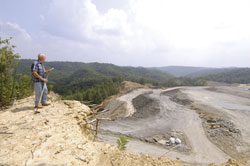We followed McKinley Sumner, a spirited, fit 74-year-old, up the side of a ridge high above his boyhood home in the mountains of PerryCounty, near Vicco, Ky.There was no discernible trail, as Sumner, armed with a hoe to protect us from copperheads and rattlesnakes, recounted his family’s history on the land and the recent trouble he’d encountered with ICG (International Coal Group, a mining conglomerate) while leading the way. The company’s earthmovers had lopped off 25 feet of his land, removing markers and several 100-year-old trees noted on a survey for which he’d paid $6,000. “It was a good thing I came back here when I did. They will sneak in at night and destroy an entire ridge,” said Sumner.
 |
McKinley Sumner looks out on mountain-top removal mining from the edge of his Perry County property. |
 |
A surface-mining operation tears away at the top of a Perry County mountain. |
Kentuckians for the Commonwealth, a grassroots social justice organization, had organized a two-day study for us in the hills of eastern Kentucky. Our meeting with Sumner was our first stop. Guiding us from place to place was Kevin Pentz, a staff member and organizer for the Canary Project, a division of KFTC dealing with coal and mining issues. Started in 1981, KFTC, among other efforts, works with communities to help protect their land and water from the impacts of certain mining practices. The group has advocated for state legislation directed at abuses of “broad form deed” contracts (which often give mineral-rights holders — coal companies — the right to extract coal by any means necessary, including surface mining) and at requiring coal companies to monitor groundwater quality. KFTC’s efforts also helped save the state’s tallest peak on Black Mountain (4,145 feet) in 1998 when Jericol Mining Inc. sought a permit to mine the mountain through mountain-top removal — a method of coal excavation in which  forests are razed and explosives blast the mountaintops away to access shallow and deeper horizontal coal seams, dumping the cut trees, earth and pulverized rock, called “overburden,” into the valley below.
forests are razed and explosives blast the mountaintops away to access shallow and deeper horizontal coal seams, dumping the cut trees, earth and pulverized rock, called “overburden,” into the valley below.
One of KFTC’s most effective tools for raising awareness is its Mountain Witness Tours program. Not your typical sightseeing tour, it has participants interact with a community of people on a one- or two-day glimpse into the lives of those directly affected or threatened by destructive coal-mining practices. The impact of the tours turns out to be
Mountain Witness Tours?run monthly. Call Kentuckians for the Commonwealth,
(606) 878-2161, for more details. Donations are appreciated to cover staff time and travel expenses. |
.
Our next stop was dinner with 62-year-old Vietnamvet Carl Shoupe in tiny Benham (pop. 600), a tidy, once-booming town nestled in a valleyof BlackMountain in HarlanCounty. “I grew up in these mountains,” he said. “Now when I take my grandchildren to spots I remember, it is totally different. There were places where the sun never shined in the mountains and special kinds of plants grew there and now it’s just gone.” Even the benefits of coal mining have diminished, with surface-mining techniques requiring many fewer employees resulting in the loss of mining jobs. According to statistics compiled by Kentucky’s Office of Mine Safety and Licensing, the U.S. Mine Safety and Health Administration and the U.S. Census Bureau, coal production in Harlan County declined slightly from 1980 to 2005 (a 10 percent decrease), while mining jobs fell by 56 percent (bigger mining
 |
Coal-company roads snake through a Letcher County mountain valley. |
machines and explosives have replaced men). Although this county has produced nearly a billion tons of coal in the past 100 years, it is still one of the poorest counties in the state, with 8.2 percent unemployment and 33 percent of the residents living in poverty. (McKinley Sumner’s Perry County doubled its coal production between 1980 and 2005, but saw its mining jobs shrink by 50 percent.)
The next day we traveled to a mountainside near Eolia in LetcherCountyto meet Sam and Evelyn Gilbert. Sam, 60, who raises champion bird dogs (with tables full of trophies to prove it) has visited 39 states and said he and his wife, originally from Arizona, can’t imagine living anywhere else but these mountains. They welcomed us into their living room, where framed medals hung on the walls from Sam’s tour of duty in Vietnam. He now finds himself at war with a different enemy. “You never feel safe. Things happen and there is no feeling of security,” he told us. Even his recent victory against Cumberland River Coal Co., which pledged to withdraw its permit application for a valley fill (dumped overburden from the mine site) that would have buried two miles of stream behind the Gilberts’ home is little comfort. “They can always petition under
 |
Mountain homeowner Sam Gilbert has had to battle a coal company’s attempt to dump mining spoil into the stream bed that runs through his property. |
another one of their company’s names. Even though they say there’s an 80 percent chance they won’t be back, it’s that other 20 percent that scares me to death,” he said.
We piled into Gilbert’s truck and he drove us up on a ridge of BlackMountainto a 3,000-foot-high strip-mine operation. The only traffic we encountered was a steady stream of heavily loaded coal trucks barreling down the road.
“I go from being sad to angry,” he said, looking out over the scarred landscape. “Appalachian people are not throwaway people — their heritage and inheritance have no bearing on the coal companies. They don’t care about the mountains or us as a people. The coal company sees no value in anything but revenue.”


 forests are razed and explosives blast the mountaintops away to access shallow and deeper horizontal coal seams, dumping the cut trees, earth and pulverized rock, called “overburden,” into the valley below.
forests are razed and explosives blast the mountaintops away to access shallow and deeper horizontal coal seams, dumping the cut trees, earth and pulverized rock, called “overburden,” into the valley below.



